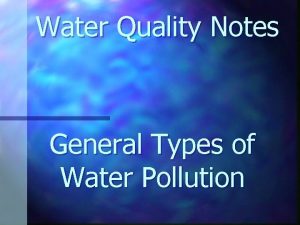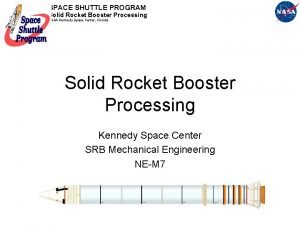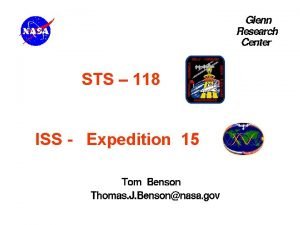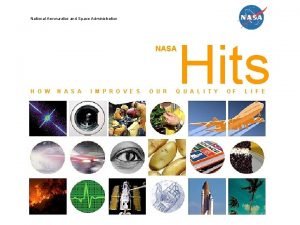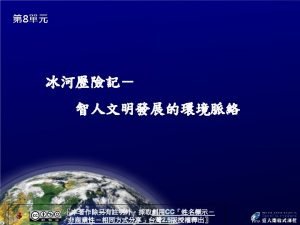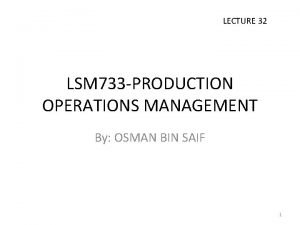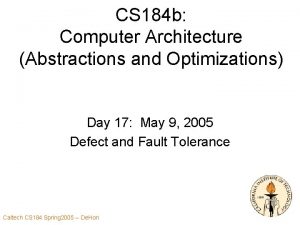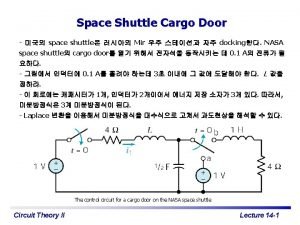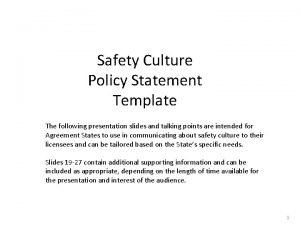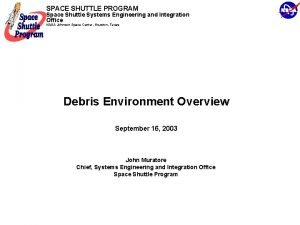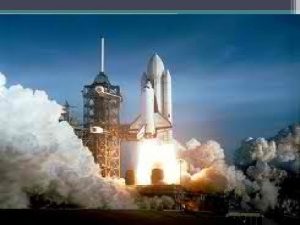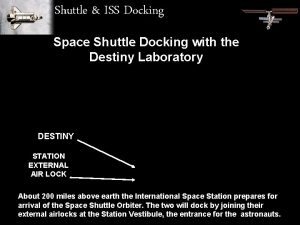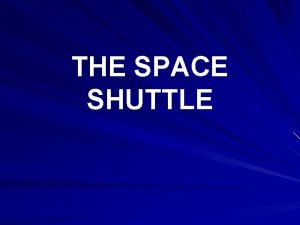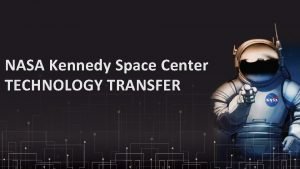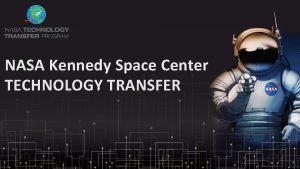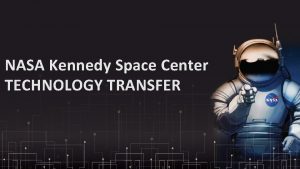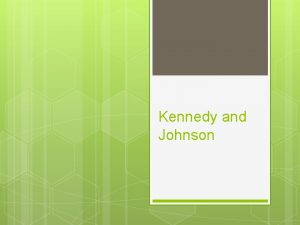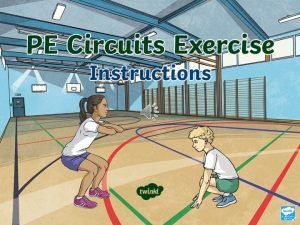SPACE SHUTTLE PROGRAM MPSSSME TIM NASA Kennedy Space











- Slides: 11

SPACE SHUTTLE PROGRAM MPS/SSME TIM NASA Kennedy Space Center, Florida Stephen Coester MPS STS-1 FLOW STS-1 Retrospective-How we went from Nothing To Something 1976 -1981 1

SPACE SHUTTLE PROGRAM MPS/SSME TIM NASA Kennedy Space Center, Florida Stephen Coester Something to keep in mind…………. When I started on the Shuttle program in 1978 there were no personal or office computers. We didn't get our first Macs until the mid 1980 s. It was all pencils and paper, calculators, drafting tables, typewriters and carbon paper. The only repro machine was over in the LCC, a giant Zerox. Secretaries really earned their pay: Priscilla, Pat, Wanda and Ruth were always typing. How things have changed since then. 2

SPACE SHUTTLE PROGRAM MPS/SSME TIM NASA Kennedy Space Center, Florida Stephen Coester Ancient History 1969 - A reusable Space Transportation System and SSME development were authorized by President Nixon. 1972 -Contracts awarded for Enterprise, Columbia and STA-099 Test Article (Later Challenger). Columbia AFT Fuselage construction started in 1976. Enterprise conducted ALT (Approach and Landing Test) June-October 1977. That's when I decided to leave unmanned launch as Shuttle was going to replace everything. MPTA (aft fuselage and three SSME) mated to ET in 1977 at Mississippi Test Facility (Stennis). John Plowdon was the Test Conductor/Manager. First static firing in 1979. Two serious SSME malfunctions damaged the structure and delayed testing. SSME's validated for flight just three months before STS-1 launch in January 1981. In KSC HQ area, LETF started in early 70 s to checkout TSMs, Swing Arms, etc. By 1977 the Launch Processing System (LPS) was taking shape. 3

SPACE SHUTTLE PROGRAM MPS/SSME TIM NASA Kennedy Space Center, Florida Stephen Coester Rockwell MPS group at KSC started in 1976 with the hiring of Bob Bucina. By the time I arrived Bill Heink, Gary Frank, Dick Carlson, Hank Crotskeys and Tim Mc. Coy (later ECLSS) were onboard. After me came Bob Bowman, Roy Masters, John Sterritt, Jim Labelle, Mike Phillips, Glen Waldrup, Wes Lineberry, Alan Deluna, Ken Kirkland, Roy Austin, Larry Irminger, Marty Winkle, Lou Lemire, Steve Hansell, Jim French and Fin Jones. Kathy Hahn was our software expert. Ken Smith was our Designee. We were located in the O&C Building, but soon moved to Tower "D" of the VAB and then to the trailers. Our NASA counterparts were Graydon Corn, Russ Rhodes, Bob Ward, Warren Wiley, John Neilson and John Simon, Don Bier, Ken Kline, Sonny Jones, Frank Izquierdo and Mac Mc. Caskey. 4

SPACE SHUTTLE PROGRAM MPS/SSME TIM NASA Kennedy Space Center, Florida Stephen Coester I hired in as an MPS senior engineer having worked Saturn V LH 2 for nine years on all of the Apollo and Skylab missions and five years on Atlas-Centaur as Centaur Pneumatics. On my orientation tour I was taken to Firing Room 1. There were twelve identical sets of six CRTs each. I asked which one is MPS? They said, "Doesn't Matter. " Well this blew my mind since on Saturn/Apollo and Atlas-Centaur we had our specific consoles with all the switches and gauges for each system and all the test engineer had to do was figure out which switches to throw to perform which test. If it didn't work you called for the electrical engineer. I then asked how we used this magnificent LPS system and was introduced to GOAL (Ground Operations Aerospace Language) and told that we would create the software necessary to operate the MPS. It was state of the art in 1978. That was April 1978. OV-102 Columbia wouldn't arrive at KSC from Palmdale until March 25, 1979. 5

SPACE SHUTTLE PROGRAM MPS/SSME TIM NASA Kennedy Space Center, Florida Stephen Coester Basically we started with MPS drawings and Electrical Schematics During that eleven months a small group of MPS and SSME engineers designed and wrote all of the operating software for MPS including prerequisite and reactive control logic. This was done by printing the code on big green sheets of paper and each night turning them in to the key punch operators. The next morning we'd get back reams of paper printed by the compiler showing our code and the thousands of errors that had been detected. This repeated adding a little more code each day until the software was error free and accomplished operation and control of our system. . We had good electrical schematics and the engineering drawings to work from, but no hardware. There were minimal or no software specifications. At the time I was most amazed by the program written to check MPS electrical redundancy. What would have taken hours on any previous program only took minutes on LPS. There were no software engineers except for one assigned to each group to model the system per the system engineer's specs. Ours was Kathy Hahn. I think all of the modeling engineers were female. There were no female test engineers in any system until I hired Melinda Dana (now Tribe). 6

SPACE SHUTTLE PROGRAM MPS/SSME TIM NASA Kennedy Space Center, Florida Stephen Coester In addition these same MPS and SSME engineers designed the Firing Room CRT displays or skeletons, which in the case of MPS were system schematics for LH 2 and LO 2 and tabular formats for helium and SSME. The mouse hadn't been invented yet but the test engineer could move the cursor from the keyboard to open a valve, start a pump, etc. Next, using Software Verification procedures (SVP) prepared by the same engineers, the software was run against the model which we hoped really did simulate the real hardware and electrical system to verify every line of code. Finally the software was ready to be used against the actual Shuttle MPS system. We also worked with Jimmy Rudolph and Mark Dezendorf on preparing the LO 2 and LH 2 propellant loading, criteria, software and procedures. At the same time the same small group of engineers was using the OMRSD which was only about fifty pages long to create from scratch all of the test and checkout procedures such as V 1009 which would be used to verify the MPS and SSME systems were ready for flight. We had to work with Downey and JSC on Launch Commit Criteria. 7

SPACE SHUTTLE PROGRAM MPS/SSME TIM NASA Kennedy Space Center, Florida Stephen Coester The interface and division of responsibilities between Rocketdyne SSME and Rockwell MPS were not yet specified and had to be worked out. The agreement that Rocketdyne would do all the hands on work on the SSMEs and Rockwell would perform the testing that involved both SSME and MPS was forthcoming. Other engineers were trying to get a handle on all of the GSE for handling the SSME's and MPS components. This was a tough assignment with GSE that had never been tested or fit checked. Others were traveling to SAIL at JSC to help integrate MPS/SSME software with the GPS flight software. And we worked with the Test Conductors to create the integrated procedures for orbiter-ET umbilical mate, propellant loading, CDDT, FRF, Launch etc. It was a busy year. We worked many seven day weeks and twelve hour days for long periods. Each morning was a 0800 Manager's meeting. Everyone had the thousand yard stare from exhaustion. All through STS-1 processing we continued to work really long hours. 8

SPACE SHUTTLE PROGRAM MPS/SSME TIM NASA Kennedy Space Center, Florida Stephen Coester I think I was the only KSC MPS engineer to spend some time at Palmdale actually getting some hands on experience in the aft fuselage while Palmdale did their pre-delivery checkout. I also went to NSTL to observe propellant load and engine firings on the MPTA as had Bill Heink before me and then John Sterritt. These trips were invaluable to learn what the actual Shuttle looked like and how it operated. Here's the timeline for Columbia (OV-102) and STS-1: 03/24/79 - Arrival at KSC from Dryden (Palmdale) 03/25/79 - Move to OPF-1 (610 days) 11/24/80 - Move to VAB-3 (35 days) 12/29/80 - Move to PAD-39 A (105 days) 02/20/81 - Flight Readiness Firing (FRF) 03/19/81 - John Bjornstad and Forrest Cole died in aft fuselage of GN 2 asphyxiation after CDDT. 04/12/81 - Launch 04/14/81 - Landing at EAFB. 04/28/81 - Return to KSC (14 days) You'll note that we spent almost two years in the OPF for the first flow. 9

SPACE SHUTTLE PROGRAM MPS/SSME TIM NASA Kennedy Space Center, Florida Stephen Coester Everything was new to engineers and techs. No one knew where anything was located and the procedures had not been written in the most efficient manner for moving around the Aft. Platforms didn't fit. GSE didn't work or we had to figure out how to use it. Our engineers, techs, and QC's were working around the clock. Hundreds of PR, TPS, PCR were written. Thank goodness for Tile. They provided the umbrella for all the other systems to get their acts together. One example of things not fitting was the engine mounted heatshield. We had an early SSME on the floor in the MSOB and spent weeks trying to install the heatshield. It was impossible to get all of those tiny attach holes lined up. The designer said the tolerances had to be so tight or else the bolts would warp from reentry heating and they'd never come out. Finally we asked him to come to KSC to assist and after less than a day of frustration he said, "Ream out those holes!". There was no interval testing. Every OMRSD item had to be verified and as mentioned the OMRSD was quite small at first. As we were writing the procedures and performing the tests we kept coming up with more things that needed verifying and the OMRSD grew and grew to over five hundred pages. It was common for John Young or Bob Crippen to drop by the MPS console in FR-1 and ask how things were going. They were understandably concerned about the SSME problems at NSTL. 10

SPACE SHUTTLE PROGRAM MPS/SSME TIM NASA Kennedy Space Center, Florida Stephen Coester There were endless problems like that. We over spun the LH 2 recirc pumps to 40000 RPM and over pressurized the helium tanks to 6000 psi. a couple of bad days, but neither sets of components had to be replaced. It did a number on the Time/Cycle calculations. Finally we reached the first all systems integrated interface test (S 0001 -OIT) run by the Test Conductors. It took at least three weeks to complete. Day after long day in the Firing Room. That test should take a couple of hours. After several frustrating long days, at the end of another scrub, I came up on the net and suggested we might consider taking one of the weekend days off. That was greeted by a long silence, but the Rockwell director finally agreed we could use a short break and we got a Sunday off. I was a hero to the troops if not management. During the very first FRF (Flight Readiness Firing), for a moment, we thought we were losing the vehicle when the engines started at T-3. 8 seconds and the whole stack started tipping over. Fortunately it returned to vertical from its three foot sway. That's why now the SSME's are ignited at T-6. 8 seconds. FRF gave the MPS/SSME community a good feeling that we could perform a propellant load and start the engines. I'm not sure anyone was 100% confident the whole complex machine would actually fly. STS-1 launched on 4/12/81 after only one scrub on the 10 th due to a GPC problem. 11
